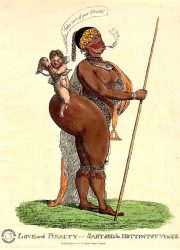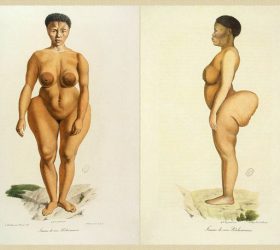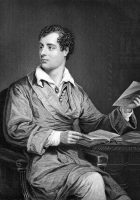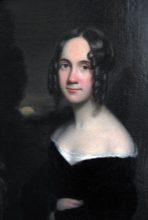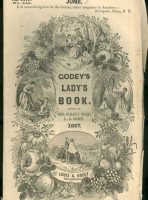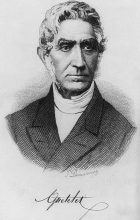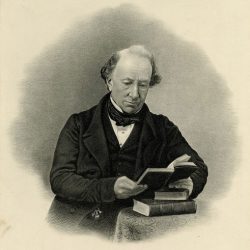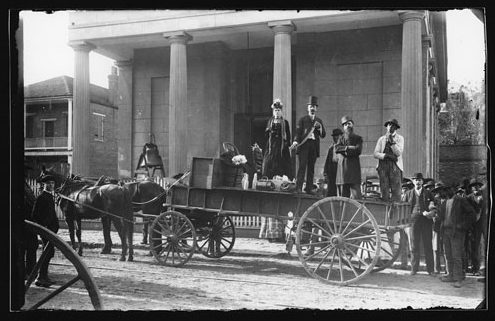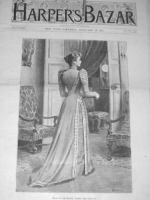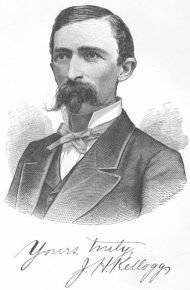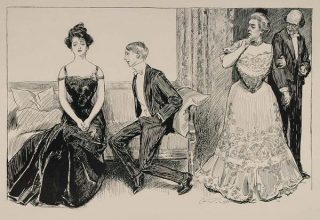1800s The Romantic period, which included a subtle rise in female authors. Cultural assumptions were that Blackness = Fatness, and that Whiteness = Thinness. Noted contemporary author Sabrina Strings observes this time as the birth of the Ascetic Aesthetic, which is characterized by severe self restraint with the intention of looking a certain way. Enslavement reached a peak. Most people lived on farms and grew their own food at the start of the 1800s, but advancements in the agricultural industry birthed commercial farming, which was expensive. Commercial farms versus small farms was one of the ways social class hierarchy was delineated.
1790-1840 Spurred by charismatic, evangelical ministers, the Second Great Awakening (a Protestant revival movement) occurred. Ministers encouraged and empowered women’s involvement in church activities and roles. Religious messages remained focused on temperance, especially around alcohol, which eventually led to Prohibition.
1801 Joseph Marie Jacquard invented a loom that used punched wooden cards to automatically weave fabric designs. This automated punching of wood cards was used in early computer designs.
1803 Louisiana was purchased from France.
1804 Lewis and Clark were sent by President Jefferson to chart Western North America.
1806 Saartjie/Sarah Baartman, an enslaved fat, black female in Cape Town, was one of the two remaining captives of her black owner, Hendrick. To pay off his debts, Hendrick displayed her in front of sick and dying British soldiers for money. The soldiers had heard of the insatiable sexual appetites of black women for a hundred years. For an extra fee men may have been able to touch her and even have sex with her. Alexander Dunlop, a Scottish doctor, convinced Sarah’s owner to travel back to Europe with himself as her handler in order to show her off to Europe and make a lot of money. Sarah was promoted as an erotic and scientific ethnographic freak show.
1808 Due to the robust forced breeding program of captives in America, the US Congress outlawed the Trans-Atlantic Slave Trade and prioritized domestic enslavement.
1810 Samual Stanhope Smith, Presbyterian minister, wrote Essay on the Causes of the Variety of Complexion and Figure in the Human Species. In it he reported that Americans have thinner, more slender bodies than Irish and British people. He attributed the more svelte frame of Americans to the cold climate.
1812 The War of 1812 halted immigration from European countries into America.
1820 Irish Catholics began immigrating to America in droves. From 1820 until 1860, they comprised up to 1/3 of all immigrants to the US. Germans were the next largest immigrant population. The immigrant populations overwhelmed cities and shifted American demographics in terms of ethnicity and religion.
1820 Textile and clothing manufacturing was growing quickly. Up until this time, everyone made their own clothes or hired seamstresses. Now, pre-made garments were being made, and people would purchase them, hoping that they would fit. Most women knew how to sew and were taught sewing skills as a child, which meant they would still make some of their clothes or alter the store bought garments. Sporting fancier versions of pre-made clothes was one way a family’s wealth level could be distinguished.
1820s and 1830s. The first abortion laws were passed in the US. These laws prohibited the sale of abortifacients, which at the time were herbs intended to induce abortion. Despite these laws, which were essentially poison-control laws, abortions continued and were widely available. A fetus was not considered to be alive until quickening, when the pregnant person felt it first move at approximately 4-5 months, and abortions up to this point were still legal. Pregnancy and abortions were primarily dealt with by midwives.
1825 Fad Diet: Low Carbohydrate Diet, which appeared in The Physiology of Taste by Jean Brillat-Savarin
1828 Sarah Hale accepted a position as editor of Ladies’ Magazine, which was founded by Boston clergyman John Lauris Blake. Initially, the magazine published poems and stories. Hale included several articles on fashions due to popular requests, but she did so begrudgingly. After a few years, the magazine stopped running fashion articles all together, and not long afterwards it lost readership and funding.
1830 All white men, regardless of money and property, had citizenship rights. Around this time, several reform movements and organizations were getting established, such as women’s suffrage movements, temperance leagues, moral-reform societies, and anti-slavery organizations. Women played primary roles in most of these.
1830 The Federal Indian Removal Act of 1830 evicted Native Americans east of the Mississippi River to Oklahoma, which had been deemed Indian Territory. Over 100,000 Native Americans were forced to move. Land, animals, and food sources were destroyed. They were fed government issued rations meant to be temporary food sources until they settled into Oklahoma. The colonial assumption that they could live off the new land was grossly incorrect. They were now severely traumatized and disenfranchised people living in a place with a different climate. They had little to no knowledge of this new land and the available food resources, which forced Native peoples to become dependent on the food rations that were never enough to feed their tribal members.
1830 Sylvester Graham, Presbyterian minister, met William Metcalfe. Reverend Metcalfe was preaching on vegetarianism and promoting George Cheyne’s dietary advice of portion control and water therapy in the pursuit of Godliness. Graham was a believer. He took these messages and used them to reinvigorate the old Protestant food morality beliefs in America. He preached that certain foods weren’t just gluttonous, but were also bad for your health. While he didn’t invent the good food/bad food dichotomy, he did proselytize it. To Graham, sugar, caffeine, meat, spices, yeasted bread, condiments, and alcohol would cause indigestion, illness, civil unrest, and lead to ungodly sexual appetites in men, including masturbation, whether married or not. His story sounds like the orthorexic diet culture of today, sans the sex talk. He claimed certain ‘bad’ foods made his health poor as a child, and once he cut them out of his diet, he felt better. What he didn’t share was that his childhood was full of trauma. By the time he was an adult, he was reportedly an exhausted and bitter person. He encouraged his followers to eat only bland, unstimulating food for health and morality, which he believed would make a person robust. His followers feared becoming too thin, so he and several set about to prove the naysayers wrong. For the first time in recorded history, people weighed themselves to determine if their diet caused weight loss or not, although the intention was to not lose weight. Their experiences proved what we still see time and time again with any version of restricted eating; they lost a little bit of weight initially and then gained it back or maintained the same weight.
1830 Fad Diet: The Graham Diet. Followers were called Grahamites and popularized Sylvester Graham and his dietary ideas.
1830 Ralph Waldo Emerson, prolific American writer, asked in a journal entry, “was ever the full feeder ready for the religion?” He contemplated the spiritual commitment of people who eat until full.
1830 Sarah Hale published her second book of poetry, Poems for Our Children, which included Mary Had a Little Lamb.
1831 Godey’s Lady’s Book published an anonymously written article stating that instead of overeating then tightly lacing their corset, women should practice “a well-timed use of the table followed by gentle open-air exercise.” It also stated that bread and butter are “hostile” to female delicacy.
1833 Ralph Waldo Emerson, American writer and Boston native, traveled to England and met Thomas Carlyle, who was considered an expert on the Anglo-Saxon race. Both men were devoutly religious. Carlyle was a Calvinist and Emerson an ordained Unitarian minister. The friends encouraged each other’s fervor for and writings about Anglo-Saxon supremacy.
1835 Colonials were in the midst of trying to create and understand what it meant to be American. Social hierarchies were being structured and restructured, and the middle class was growing as factory jobs increased. This led to the establishment of class hierarchy within factories; supervisors and managers were of a higher class than the factory workers, and so forth up the management chain. The expansion of the middle class increased affordable luxuries for many people who would not have had access to any wealth before the Industrial Revolution. This also brought about a new group of middle class women who had a zeal for religious ideals. They sought guidance from new women’s only magazines that were uniquely devoted just to them, unlike the vast majority of other books and magazines at the time, which were all written by and cultivated for males. These women’s magazines, though owned by men, hired female editors and writers. This type of job was new for women.
1836 Louis Godey, owner of Godey’s Lady’s Book, purchased Ladies’ Magazine. Godey’s Lady Book was full of fashions and jewelry. Sarah Hale, a widowed working mother of five children, loathed fashions for ladies of leisure and valued educating women. She rationalized her involvement in this magazine as an effort to educate her readers on how to be a Godly woman. She educated women on their duties as moral gatekeepers of their homes, which included their relationship to food, how much to eat, what to eat, how to behave, and how to be beautiful.
1836 Lambert Adolphe Jacques Que’telet, Belgian mathematician and sociologist, created the first height/weight tables to assess the characteristics of average men in Britain. The tables weren’t helpful and had many flaws, so they were not used in his studies at this time. They drew a small sample size of only white males and all were under 30 years old. Quetelet is also credited with creating anthropometry, including the race pseudoscience, phrenology.
1837 The Victorian era began. Women were celebrated if they were not as round as their English counterparts but still plump, pale, and hourglass shaped, thanks to corsets and poofy skirts. This was also a sign of affluence and social status, which meant their husbands made enough money to afford for the wives not to work. Prominent collarbones and hollowed cheekbones were thought to be defects.
1838 Cherokee Trail of Tears. Cherokee rights were taken away, and they were forced to move to Oklahoma from North Carolina. Many perished.
1840 Factory-made machinery for agriculture increased commercial farming practices and farmers’s need for money and credit to pay for machinery.
1841 Researches into the Physical History of Mankind by James Cowles Prichard described the racial distances between Anglo-Saxons, Asiatic Celts, and North Africans. He had an entire section on the Physical Character of the German Nations, in which he described Germans to be of robust and tall form, fair skin, red hair, and blue eyes. This was in contrast to the Celts, who had dark hair, dark eyes, small forms, and “swarthy complexions.” His language mirrored historical descriptions of African people being dark and little. He claimed Irish Celts were Asiatic and Semitic in order to link them to ancestral African ethnography.
1843 Sarah Hale, editor of Godey’s Lady’s Book, decided to change her mind about including fashion in the magazine. Previously, fashion was a distraction from the written articles on women’s morality and purity. Now, she included them as examples of Puritan morals, temperance, and asceticism. She wrote, “the Anglo-Saxon race of women are taller and slenderer than the Grecian females; and, if we may credit history, far more lovely.”
1846 Thomas Carlyle writes an essay blaming the Great Famine in Ireland on the gluttony of the Celtic Irish and their lack of self control, claiming their reliance on potatoes was an obsession and was the source of gluttony. To Carlyle, the difference between fat people and their gluttony in England versus fat people and their gluttony in Ireland was that the English, aka the Saxons, could reform and be better.
1846 John Hutchinson, a British Surgeon, created a weight and height table of 30 year old men from 5’1″ to 6′. This table was utilized by life insurance companies to assess risk in applicants of all ages, for decades.
1847 The American Medical Association was formed.
1848 Seneca Falls Convention: a group of abolitionists gathered in Seneca Falls, New York to discuss women’s rights, especially women’s right to vote on the basis that all men and women were created equal.
1849 The Bureau of Indian Affairs was established. The same year, the US Army incarcerated Navajo tribes on a reservation.
1850 Just like in England, where industrialization occurred in the US, cities followed. Irish, German, and Jewish immigration into the US continued, and around this time Chinese workers slowly began immigrating to America, as well. Death rates among enslaved peoples were high across the Americas, which fueled the need for more and more slaves. In the US, the fertility rate was 80% higher than in the rest of the Americas, and by the 1850s, enslaved people in the US were in their 3rd, 4th, and 5th generations. This differentiated US slavery from the rest of the slave industry at this time. Pregnant enslaved people were allowed to perform slightly less and were given breaks from field work right before and after childbirth. The mortality rates, however, were still very high; the death rate for black children was twice as high as it was for white, southern children. This was largely due to chronic undernourishment as black babies were forced to wean from their mothers at 3-4 months, whereas white children were encouraged to breastfeed until at least 8 months, if not longer. Under nourishment, lack of clean living conditions, and lack of medical care guaranteed that the disease and death rate of enslaved children was double that of white children.
1850 Medicine shows started to gain popularity in the US and remained popular through the mid 1900s. Medicine shows were traveling performances that also sold miracle cures and elixirs. They became the template for today’s marketing, entertainment, and medical fields in America. Performances included burlesque, comedy, minstrels, magic, dog and ponies shows, and theatrics. There were usually white men and women impersonating Quakers, Native People, frontier scouts and Asian fakirs.
1853 Arthur de Gobineau created a three-part race system that divided people into racial categories based on skin color: white, black, or yellow. Black people were at the bottom due to their supposed gluttonous nature. He also asserted that there were differences amongst white peoples. Pure-white, Germanic groups, called Aryans, were at the top of the hierarchy, and those who had reproduced with Aryans over the centuries were the most elite white people.
1854 “The Roman Catholic Church claims infallibility for itself, and denies Spiritual Freedom, Liberty of Mind or Conscience to its members. It is therefore the foe to all progress; it is deadly hostile to Democracy. She is the natural ally of tyrants, and the irreconcilable enemy of Freedom” (Parker, 1854).
1856 Ralph Waldo Emerson’s English Traits, in which he compares Englishmen and women to Americans, was published. He claimed that though Americans largely came from England, Americans were on top of the racial categorizations due to their thin frames. Additionally, American-born, Anglo-Saxon, Protestant women were the epitome of venuses and to be adored.
1857 Horatio Robinson Storer, American gynecologist, began to campaign against abortion. He lobbied the American Medical Association (AMA) to advocate against the practice and created the Committee on Criminal Abortion. This anti-abortion campaign was a way for physicians to assert their superior scientific knowledge surrounding women’s health, solidifying their position as medical experts. They also dishonestly depicted midwives as charlatans who pushed dangerous abortion procedures on vulnerable women. Establishing themselves as women’s health authorities, as well as discrediting midwives, provided physicians access to the lucrative pregnancy market. Storer’s personal philosophy included concerns about the birth rate in America. He was afraid that immigrant children would outnumber native-born American children if U.S. birth rates continued to decline and encouraged American women to bear more children. Storer also believed that removing women’s reproductive organs, typically the ovaries, would cure them of unfeminine and immoral behavior. However, despite all this, abortions continued. Providers and patients were prosecuted inconsistently, but when they were, the women were subjected to public humiliation in the form of intense questioning and scrutiny that was often publicized by the press.
1860 There was a 567% increase in the amount of enslaved peoples in the United States between 1790-1860. The economic value of the four million enslaved people in the US was more than all the factories, railroads, buildings, as well as the remainder of the US economy combined. Land was the only thing more valuable.
1861 The American Civil War began.
1862 The Underground Railroad ended. An estimated 6000 to 100,000 enslaved people escaped this way.
1862 The US Department of Agriculture was established with the passing of the Homestead Act, which granted 160 acres of western territory to heads of families, for a minimal fee, and 5 years of continuous residence on the land. The USDA was charged with ensuring adequate and reliable food supply, as well as providing the public with useful information on agriculture subjects. It was expected that eating US crops would improve public health.
1863 The Seventh Day Adventist church was born in Battle Creek, Michigan in the height of the Second Awakening, as religious zeal was palpable across the United States. Some of the leaders of the new church, James and Ellen White, moved to Battle Creek in 1855 and became friends with John Preston Kellogg. They were all Grahamites and believed sickness was a punishment for the sins of abusing one’s body by eating, drinking, and masturbating. They also believed the Bible in a literal sense and thought that their physical body would be taken up to heaven with Jesus upon the rapture. Therefore, the path to God was to purify the physical body by taking up a vegetarian diet, abstain from engaging in self pleasure, and doing water therapy to purify the body of disease. John Harvey Kellogg (of Kellogg’s cereal), the son of John Preston Kellogg, grew up with these beliefs his entire life.
1863 Fad Diet: Banting’s Low Carbohydrate Diet. “Banting” became a slang word for dieting.
1865 In May of this year, the American Civil War ended. In December, the 13th Amendment was ratified, and slavery became illegal, except for those convicted of a crime. Confederate money was no longer worth anything. Southern banking systems were desecrated and weren’t lending out money. The US government didn’t set up a viable transportation system to support newly freed black people. So, while they were free, they were also mostly illiterate and had no money, land, jobs, or healthcare. Southern white people felt humiliated and enraged. Their money was no longer worth anything, and now they had to pay the people they formerly enslaved for labor. This gave rise to sharecropping contracts, which were a way for newly freed slaves to work the land, without immediate payment from the plantation owners. In theory, once the crops sold after the harvest, the workers and the landowners would split the profits. In the meantime, however, white store owners would allow black people to have food, medicine, and clothes on loan until they could be repaid after the harvest. Unfortunately, this never materialized as a fair trade. Cotton prices plunged, many plantation owners were dishonest, and the lack of governmental financial protections forced black people to accumulate large debts that couldn’t be paid off. Once again, they were tied to the land and working for essentially nothing. Sharecropping has been called slavery by another name.
1867 It is estimated that by 1867, 12.5 million enslaved people were taken from Africa and 10.7 million were in the Americas (including West Indies, Caribbean, Gutch Guiana and Brazil).
1867 Mutual Life Insurance Company of New York’s medical examiners created a weight and height table of American men.
1868 The 14th Amendment was ratified. It defined citizens as white males.
1869 Francis Galton termed the word ‘eugenics’ in his book Hereditary Genius, where he researched England’s upper middle class and concluded their superior intelligence was hereditary, and that desirable traits were passed down through generations. He advocated for a selective breeding program that would improve humanity by excluding certain populations, such as people of color and disabled people, from the breeding pool.
1870 The 15th amendment was ratified. It included black men as also having the right to vote.
1870 Food manufacturers were mostly in the business of canning. Up until this time, they used sodium benzoate and formaldehyde to kill microbes. In 1870, they started to use steam retort technology, which raised canning temperatures high enough to kill bacteria. Defaulted cans would explode months after being sealed.
1871 The US Congress stated it would no longer make treaties with Indian tribes but would uphold existing treaties. However, the US Army continued to overtake native lands and execute thousands of native peoples over the next hundred years.
1871 Alabama, followed by Massachusetts, stated publicly that men shouldn’t beat their wives, but it wasn’t until 1882 that the first law against it was passed in Maryland.
1872 Harper’s Bazaar magazine, under editor Mary Louise Booth, regularly published articles about fashion and food, including a regular column titled For the Ugly Girls, which gave advice to females who weren’t meeting the current expectations of femininity, controlled eating, and proper fashion. It was thought that the gluttonous, inferior women would read this article and reform their ways.
1874 Barbed wire was invented, which allowed farmers to fence in rangeland, limiting open range grazing.
1875 John Harvey Kellogg had graduated with his medical degree and became superintendent of the Western Health Reform Institute, which was founded by his family friend and church leader, Ellen White. He renamed the institute the Battle Creek Sanitarium, aka the San.
1876 John Harvey Kellogg worked with a nurse named Ella Eaten (who later became his wife) to create a health-based dietary routine that treated food and water as medicine. He believed this was a way of correcting the health of Anglo-Saxons. The dietary regime led to food experimentation with grains and nuts and early imitation meat products. It was here they first created soy milk in America, peanut butter, and the process of toasting cereals. Peanut butter wouldn’t become the staple it is today until 1896 due to the innovations of African American George W. Carver.
1876 Robert Koch (German) discovered that bacteria causes illness and launched the Germ Theory. Germ Theory is still accepted as the explanation behind infection transmission for many illnesses.
1876 Cesare Lombroso published a book called Criminal Man. He is thought to be the founder of criminology studies. He believed that people of color were a different subspecies who were prone to criminal activity and related to apes. He described criminals as having animalistic features and that being a criminal was in their ancestry.
1877 A Harper’s Bazaar article titled Our Women Growing Plump, stated that previously “young American women were ashamed to show a hearty appetite in public. They were infected with Byronic philosophy: they wanted to be spiritual-as if all true spirituality did not rest on sound physical conditions.” According to the article, American women were no longer as thin as they used to be, although they still weren’t as fleshy as European women. A round body was said to be the result of the age of the country in which they lived. The author stated that American women, “live too much through the mind to live quite comfortably through the body, and the body suffers in consequence.” It goes on to assert that American women were taking better care of themselves now that the country was more developed and that they no longer “pinch their waists to semi-suffocation; when they sacrificed comfort and health to what they conceived to be appearances- those foolish and unhappy days have gone forever, [and] have barely bee unknown to the rising generation…they no longer think that to be unhealthy is to be attractive; that pale faces and compressed lungs are token of beauty.” The author continued, “American women today eat as much as they want, and more wholesome food than they once ate, they walk more; court the open air; cultivate their bodies as well as their minds; believe in perfect digestion, unbroken sleep, the glow and glory of unblemished health. No wonder their proportions are fuller, their cheeks more blooming, their eyes brighter, their step more elastic. The growth of the country and their own common-sense are serving them generously. They are not likely to become gross and obese as so many of their European sisters are; the character of the country, its institutions and its atmosphere, with their own temperament, will preserve them from that.”
1880 Massachusetts General and the New England Hospital for Women and Children introduced medical forms to collect biometrics and vitals such as pulse, temperature, respiratory rate, height, and weight. Often, weight was not filled in.
1881 In Imperial Russia, Jews left in droves after being blamed for the assassination of Tsar Alexander II. Russian state officials were trying to exterminate them and re-create a racially pure Slavic nation. Jews had immigrated to the US before, but immigration increased dramatically during this time.
1881 The Proprietary Association, a trade association of medicine producers, was established and supported by the press because journalism had become dependent on advertising money.
1882 The Chinese Exclusion Act was passed, which banned Chinese immigrants from entering the US. White Americans felt that Chinese immigrants were too successful. While they comprised only 0.002% of the population, Chinese immigrants were blamed for causing low wages, not unlike similar false sentiments towards Latinx people in America today.
1883 The Journal of the American Medical Association (JAMA) was created. John Harvery Kellogg, having recently joined this association, became one of the journal’s contributors shortly after it’s creation. He published eleven articles in JAMA between 1883-1920, mostly concerned with refined white women who didn’t eat enough of the right foods and were too thin to bear children to keep the Anglo-Saxons at the top of the racial hierarchy.
1885 Penny scales were put up in drugstores and grocery stores. They measured body weight to the nearest pound. Within a year, these coin-operated scales could be found in railroad stations, subways, banks, movie theaters, and office buildings. The availability of public scales emphasized quantifying one’s health and moral worth in pounds. People equated pounds on the scale to fat on the body instead of considering the body as a whole, composed of bones, muscles, organs, and other tissues, including fat.
1885 People were beginning to correlate water to disease spread, so state and city municipalities began experimenting with public water services and supplies.
1887 Agriculture research began in earnest with the hatch Experiment Station Act.
1890 The Morrill Act expanded land grants and funding for black land grant schools. The Frontier settlement era ended, and the First Federal Meat Inspection Act passed.
1890 Elizabeth Bisland wrote an article in Cosmopolitan Magazine called Famous Beauties about the unrivaled American beauties of northern European racial descent. She described American beauties as delicate perfections of loveliness who were tall and slim. She claimed that thinness was an aspect of American exceptionalism. Other writers around this time published similar descriptions of white, slim beauties as Native beauties from Nordic ancestry.
1890 The National American Women’s Suffrage Association was created after merging several other suffrage organizations. Instead of stating men and women were created equal, they argued women’s right to vote was necessary because they were created differently from men. This change was a compromise designed to include the temperance movements of religious morals and the new middle-class, white women who were swayed by Anglo-Saxon discussions about American beauty and idealism. The new language silenced the voices of black suffragist leaders like Frances Ellen Watkins Harper, Mary Ann Shadd Cary, Mary Church Terrell, Nannie Helen Burroughs, and Ida B Wells, who were involved due to the human rights and racial violations of the Jim Crow era. Instead of focusing on national politics, the new association lobbied for women’s right to vote on a state by state basis.
1890 The Gibson Girl was created by Charles Dana Gibson for an advertisement in Life Magazine. The Gibson Girl was a drawing of what he perceived as American Beauty, not so frail as the fragile lady of the previous century, but not so voluptuous as the women of the Victorian era. The Gibson girl was said to be a compilation of various teen models, most of which were modeled after a portrait of Evelyn Nesbit at age 16. She was depicted as an upper to middle class, pale, white woman with an hourglass shape, an unrealistically tiny waist, and tall athletic body. She was tall, slender, but also drawn with ample breasts and curvy hips and buttocks. She also wore less frilly clothing than what was typical in the Victorian era. Over the next two decades, Charles Gibson used these images to create a character that simultaneously rebuked and claimed the women’s suffrage movement. The images became wildly popular and were used to sell just about everything. Some of the depictions portrayed women playing sports and generally participating in life, which was a groundbreaking departure from the typical depictions of women sitting around looking pretty. The Gibson Girl was advertised as the “New Woman.” Female buyers purchased most everything the Gibson Girl image was attached to in hopes of conforming to her aesthetic and thus social standing. Even though she was just another fabrication of the male imagination, the sensation of the Gibson Girl began the advertising practice of using skinny, white women to market to women in general. There was, and is, no way any woman can live up to the aesthetic ideals created in the imagination of men. Especially when their waists aren’t even wide enough to hold organs.
1890 Hydrotherapy was marketed as a treatment for typhoid fever. This form of medical treatment was introduced by George Cheyne around 1730, which he called water therapy. It was a therapy of immersing oneself in clean/pure water. Given that clean water wasn’t normal during this time, it made sense that this would be helpful for one’s health.
1890 The Heinz Company mandated that employees get weekly manicures and take regular showers, as well as change their underwear regularly to keep bacteria out of canned goods.
1890 Determined to not have another US Census take seven years to calculate, the US Government hired Herman Hollerith to create a punch card system that could count the census faster. He used a punch card system that was similar to what was used in the first automated weaving looms. Hollerith went on to create IBM.
1891 The Immigration Act of 1891 excluded immigrants who are polygamists, convicted criminals, sick, and diseased.
1891 Ladies’ Guide in Health and Disease: Girlhood, Maidenhood, Wifehood, Motherhood, written by John Harvey Kellogg, was published. Kellogg was a Eugenist, Seventh Day Adventist minister, vegetarian, physician, avid reader of race sciences, and believed his mission was to reform women to ensure their Anglo-Saxon heritage. He believed that diet reform was mandatory for the betterment of women’s health and for the good of the race. Only he wasn’t worried about fatness, he was worried about women being too thin. In what is called “biopolitics” many doctors at this time believed women of middle to upper classes needed to gain weight in order to uplift their race. In the Ladies’ Guide, Kellogg went into excruciating detail about his opinions of women, how they were too thin, the diseases that excessive thinness caused, and how that compromised their Anglo-Saxon lineage. He compared corsets and how they deformed the body to cultural body modification practices of Africans, Asians, and Native Americans. He attributed thinness to eating the wrong foods, and his solution was for women to claim their overindulgence and to consume better foods in larger quantities. He suggested fruit, whole grains, milk, and plenty of water. He discouraged fine flour bread because he thought it was fattening.
1892 Ellis Island, the US’s first immigration station, opened.
1894 US Department of Agriculture chemist W.O. Atwater wrote in the Farmer’s Bulletin, “Unless care is exercised in selecting food, a diet may result which is one-sided or badly balanced…. The evils of overeating may not be felt at once, but sooner or later they are sure to appear…”
1895 By the end of the 1800s, a large proportion of Americans were enslaved peoples and immigrants of Irish, German, and Scottish origin. The industrial revolution birthed large factories that processed raw materials, made textiles, and created commercial farming. A new social hierarchy began to form. It was based on American Exceptionalism, worker roles within the factory organization, immigration status, purity of whiteness, adherence to Protestant ideas (specifically surrounding temperance and avoidance of gluttony), and conforming to beauty standards of white thinness. Pure whites were being distinguished from hybrid whites who were thought to have African blood in them.
1895 C.W. Post, a former Sanitarium patient of John Harvey Kellogg, opened a food manufacturing business called Postum Cereal Co. Ltd (changed in 1922 to General Foods Corporation).
1895 George R. Shepherd was appointed by the Association of Life Insurance Medical Directors of America to create an industry-wide standard height and weight table. He combined insurance company data from across the United States, which encouraged more life insurance agents to collect height and weight data of their applicants, who were all white males. Purchasing insurance was a new and growing market in the United States. It had been established in Europe for a couple of decades already and was known to protect industry by reducing sick workers and stabilizing incomes. The combination of penny scales popping up in public establishments, many middle class white men purchasing life insurance, and insurance agents asking for height and weight as a way to assess mortality culminated in a new obsession: weight and its relationship to death/mortality. Life insurance companies were wary of family physicians, and they forced medical examiners, who were not doctors, to collect data and ask about family history. They relied on the common thought of the time: that your size/shape, and now weight, indicated health, trauma, and risk of death. At the turn of the century, thinness was frowned upon and plumpness and roundness were considered markers of well-balanced health and healthy internal organs, largely due to the epidemic of tuberculosis. Thin people were thought to get tuberculosis and other diseases more easily. That said, the insurance examiners didn’t actually record weights very often, but rather made written notes about the person’s shape. Around this time, life insurance companies opened up policies to females.
1896 New York Life Insurance company reviewed the data of rejected applicants (mostly 30 years old and under white men) and created tiers of life insurance policies based on their opinions of perceived mortality risk. The first substandard policy was issued this year. Medical examiners held the power to categorize people’s risk of death and the amount of profit the insurance company stood to extract from them. This power “is referred to as biopower, which figures prominently as the [height and weight] table signaled the rise of discipline” (Foucault, 1988).
1897 George Shepherd presented his weight and mortality tables at the 8th Annual Meeting of the Association of Life Insurance Medical Directors of America. The tables included data of 74,162 white males ranging in age from 15 to 69 years old. Only 5,250 men in this data analysis had actually been weighed and measured, and measurements were taken with clothes and shoes on. The rest were estimated by “trained men.” Shepherd stated that the mortality rate was lowest in people who were 5% below average weight and for people under thirty, the lowest mortality was for people 5-10% above the average. Average weight was determined to be 24-25 kg/m² on the current BMI charts.
1898 The US took over Puerto Rico for sugar interests.
1899 First use of the word “overweight” to describe people.
1899 The first tummy tuck was performed by Dr. Howard Kelly at Johns Hopkins Hospital. He removed 15 lbs of fat from a patient’s belly.
